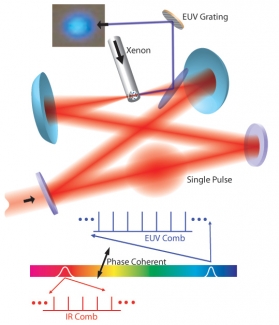Jason Jones, Kevin Moll, Mike Thorpe, and Jun Ye have generated the world's first precise frequency comb in the extreme ultraviolet (EUV) using a combination of an ultrafast mode-locked laser and a precision high-finesse optical cavity. The EUV frequency comb consists of regularly spaced sharp lines that extend into the EUV region of the electromagnetic spectrum. It is generated by coherent ultrafast laser pulses in the near infrared (which have a fixed phase relationship) whose intensities have been enhanced by nearly 1000-fold inside a passive, high-finesse, optical buildup cavity. The passive cavity allows high harmonic generation into the EUV at 100 MHz repetition rates, without requiring costly and complex active amplifier systems, which operate at kilohertz repetition rates.
The new comb is a short-wavelength version of the optical frequency combs that have recently revolutionized optical frequency metrology, precision measurement, and optical pulse synthesis and control, including demonstrations of optical atomic clocks. The new EUV frequency comb (with photon energies on the order of tens of electron volts) promises to provide an important tool for ultrahigh resolution spectroscopy and precision measurement. It will enable scientists to study the fine structure of atoms and molecules with coherent EUV light.
An article describing the discovery of the first EUV frequency comb appeared in the May 20 (2005) issues of Physical Review Letters. - Julie Phillips



 The Physics Frontiers Centers (PFC) program supports university-based centers and institutes where the collective efforts of a larger group of individuals can enable transformational advances in the most promising research areas. The program is designed to foster major breakthroughs at the intellectual frontiers of physics by providing needed resources such as combinations of talents, skills, disciplines, and/or specialized infrastructure, not usually available to individual investigators or small groups, in an environment in which the collective efforts of the larger group can be shown to be seminal to promoting significant progress in the science and the education of students. PFCs also include creative, substantive activities aimed at enhancing education, broadening participation of traditionally underrepresented groups, and outreach to the scientific community and general public.
The Physics Frontiers Centers (PFC) program supports university-based centers and institutes where the collective efforts of a larger group of individuals can enable transformational advances in the most promising research areas. The program is designed to foster major breakthroughs at the intellectual frontiers of physics by providing needed resources such as combinations of talents, skills, disciplines, and/or specialized infrastructure, not usually available to individual investigators or small groups, in an environment in which the collective efforts of the larger group can be shown to be seminal to promoting significant progress in the science and the education of students. PFCs also include creative, substantive activities aimed at enhancing education, broadening participation of traditionally underrepresented groups, and outreach to the scientific community and general public.